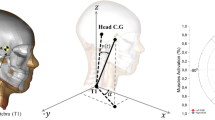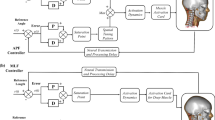Abstract.
The objective of this work is to develop a model representing the physiological systems driving fast head movements in frontal plane. All the contributions occurring mechanically in the head movement are considered: damping, stiffness, physiological limit of range of motion, gravitational field, and muscular torques due to voluntary activation as well as to stretch reflex depending on fusal afferences. Model parameters are partly derived from the literature, when possible, whereas undetermined block parameters are determined by optimising the model output, fitting to real kinematics data acquired by a motion capture system in specific experimental set-ups. The optimisation for parameter identification is performed by genetic algorithms. Results show that the model represents very well fast head movements in the whole range of inclination in the frontal plane. Such a model could be proposed as a tool for transforming kinematics data on head movements in ‘neural equivalent data’, especially for assessing head control disease and properly planning the rehabilitation process. In addition, the use of genetic algorithms seems to fit well the problem of parameter identification, allowing for the use of a very simple experimental set-up and granting model robustness.
Similar content being viewed by others
References
Amblard B, Assaiante C, Fabre J-C, Mouchnino, Massion J (1997) Voluntary head stabilization in space during oscillatory trunk movements in the frontal plane performed in weightlessness. Exp Brain Res 114:214–225
Barberini CL, Macpherson JM (1998) Effect of head position on postural orientation and equilibrium. Exp Brain Res 122: 175–184
Basmajian JV, Clifford HC, McLeod WD, Nunnalay HN (1975) Computers in electromyography. Butterworths, London
Berthoz B, Pozzo T (1988) Intermittent head stabilization during postural and locomotory tasks in humans. In: Amblard B, Berthoz A, Clarac F (eds) Posture and gait: development, adaptation and modulation, Elsevier, Amsterdam, pp 189–198
Bronstein AM (1988) Evidence for a vestibular input contributing to dynamic head stabilization in man. Acta Otolaryngol (Stockholm) 105:1–6
Davis L (1991) Handbook of genetic algorithms. Van Nostrand Reinhold, New York
Guitton D, Kearney RE, Wereley N, Peterson BW (1986) Visual, vestibular and voluntary contributions to human head stabilization. Exp Brain Res 64:59–69
Hannaford B, Stark L (1985) Roles of the elements of the triphasic control signal. Exp Neurol 90:619–634
Hatze H (1981) Myocybernetic control models of skeletal muscle: characteristic and applications. University of South Africa, Pretoria
Holland JH (1975) Adaptation in natural and artificial systems. MIT Press, Cambridge, MA
Kandel ER, Scwartz JH, Jessell TM (1994) Principi di Neuroscienze, 2° edizione, ed. Ambrosiana
Pearson K, Gordon J (2000) Spinal reflexes. In: Kandel ER, Shwartz JH, Jessel TM (eds) Principles of neural science, chap 36. McGraw-Hill, New York pp 713–736
Pedotti A, Ferrigno G (1985) ELITE: a digital dedicated hardware system for movement analysis via real-time TV signal processing. IEEE Trans Biomed Eng BME 32:943–950
Pozzo T, Berthoz A, Lefort L (1990) Head stabilization during various locomotor tasks in humans: I. Normal subjects. Exp Brain Res 82:97–106
Pozzo T, Berthoz A, Lefort L, Vitte E (1991) Head stabilization during various locomotor tasks in humans: II. Patients with bilateral peripheral vestibular deficits. Exp Brain Res 85: 208–217
Riener R, Edrich T (1999) Identification of passive elastic joint moments in the lower extremities. J Biomech 32:539–544
Sinkjaer T, Magnussen I (1994) Passive, intrinsic and reflex-mediated stiffness in the ankle extensors of hemiparetic patients. Brain 117(2):355–63
Zangemeister WH, Lehman S, Stark L (1981) Simulation of head movement trajectories: model and fit to main sequence. Biol Cybern 41:19–32
Author information
Authors and Affiliations
Rights and permissions
About this article
Cite this article
Pedrocchi, A., Ferrigno, G. Model of head–neck joint fast movements in the frontal plane. Biol. Cybern. 90, 377–389 (2004). https://doi.org/10.1007/s00422-004-0481-7
Received:
Accepted:
Published:
Issue Date:
DOI: https://doi.org/10.1007/s00422-004-0481-7




